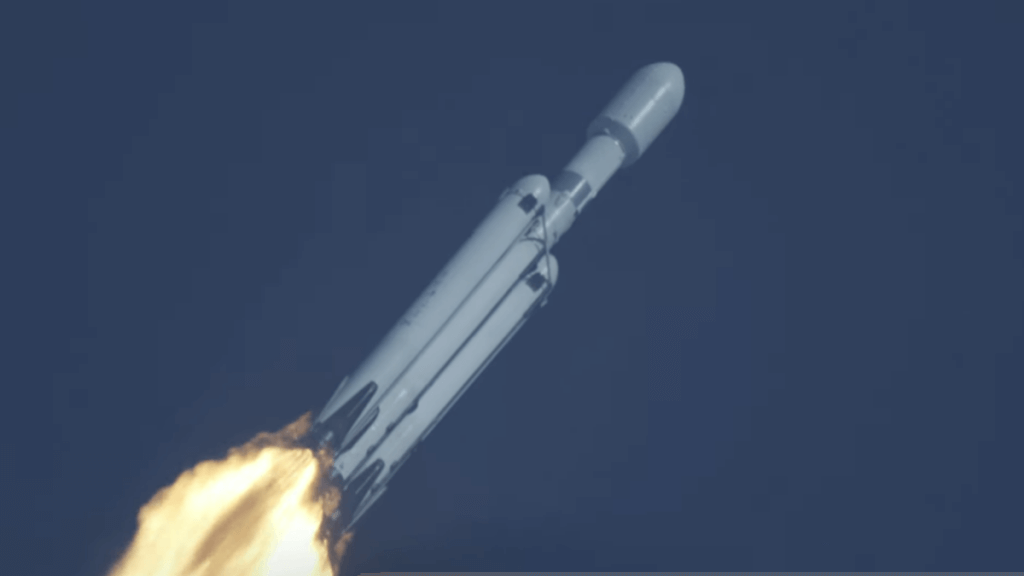When SpaceX hurled its whopping rocket into the sky Tuesday morning, that was likely the last time Elon Musk could boast he had the most powerful rocket in use — at least for the time being.
The Falcon Heavy, with 27 engines firing from a trio of boosters, launched a secret national security mission for the U.S. Space Force. The rocket is a beast, with basically three of the company’s workhorse Falcon 9 rockets strapped together, combining to offer 5 million pounds of thrust.
The impressive punch from a rocket that resembles Poseidon’s trident could be vastly outdone in a couple of weeks by NASA‘s mega moon rocket, which will soon sit on the Kennedy Space Center launchpad next door. Engineers designed the Space Launch System to have 8.8 million pounds of thrust, enough to keep eight Boeing 747s aloft. The U.S. space agency has planned its maiden voyage to the moon on Nov.14, though hardware glitches, hydrogen leaks, and weather have scuttled several previous attempts already. NASA has announced Nov. 16 and 19 as backup dates.
The relative lack of fanfare for this SpaceX launch, Falcon Heavy’s fourth since its much-hyped debut in February 2018, may be an indication of how much the space economy has evolved over the past five years, with Musk’s company leading the way. What was novel and exotic then has become seemingly commonplace today, with commercial launches announced frequently in the media.
When Musk shot a red Tesla Roadster into space with the rocket the first time, tourists jammed Florida’s Space Coast to catch a glimpse and witness the sonic booms, with a level of enthusiasm harking back to NASA’s Apollo heyday. Falcon Heavy even rose from the same hallowed launchpad that shot Neil Armstrong, Buzz Aldrin, and Michael Collins to the moon.
Spectators also came to watch the eventful landing of rocket boosters. Before SpaceX, rocket hardware was routinely ditched in the ocean after a single use. Now startups and competitors are following SpaceX’s example, wanting to recycle their equipment to lower the cost of space travel. The notion that a private company could accomplish all this earned SpaceX a new level of respect and galvanized its efforts to build an even more stupefying rocket, the Starship, to support Musk’s vision of a human colony on Mars.

Credit: Joe Raedle / Getty Images
Falcon Heavy, which hadn’t roared into the sky for more than three years because of issues with its satellite cargo, left the ground for the USSF-44 mission at 9:41 a.m. ET on Nov. 1. It’s expected to make two deliveries into an Earth orbit 22,000 miles above the equator, among them a microsatellite, known as TETRA-1, built by a Boeing subsidiary.
In a 2020 statement, Space Force’s Brig. Gen. Tim Sejba, who was then director of innovation and prototyping for the Space and Missile Systems Center at New Mexico’s Kirtland Air Force Base, said TETRA-1, and other such contracts, are helping the nation meet the “future space warfighter’s needs.”
“One of our primary goals is to be more agile in the development and deployment of innovative space assets,” Sejba said.
Want more science and tech news delivered straight to your inbox? Sign up for Mashable’s Top Stories newsletter today.
On Tuesday, SpaceX landed Falcon Heavy’s two side boosters at the spaceport in Cape Canaveral, Florida, to be refurbished for another upcoming flight. But because this particular mission required a lot of fuel — meaning Falcon Heavy was probably lifting a really heavy load — the company intentionally did not try to recover the center core like it did in June 2019 on an ocean platform hundreds of miles offshore, according to Space Force.
While Falcon Heavy may have lost some of its PR luster, it’s not lacking in demand (though there’s far more demand for its smaller Falcon 9 rocket, a vehicle that can accommodate most satellite missions today). NASA recently announced it had penned a deal with SpaceX to use the powerful rocket to send the Nancy Grace Roman Space Telescope, an infrared telescope that will study dark matter and take pictures of faraway exoplanets, into orbit in October 2026. The observatory’s total launch cost is $255 million, according to the U.S. space agency.
And though the rocket may soon lose its reputation as the most powerful operating, SpaceX could win back the accolade with its development of Starship, a super-heavy-class rocket NASA plans to use to shuttle astronauts from its future lunar-orbiting base to the moon’s surface. That’s in addition to Musk’s plans to use a fleet of Starships to one day build a settlement on the red planet.
Credit: JIM WATSON / AFP via Getty Images
Standing 400-feet tall, the Starship, an entirely reusable stainless steel contraption, could have about twice as much launch thrust as NASA’s moon rocket. Previous Starship prototype test flights exploded until one succeeded with an unscathed landing in May 2021.
At a February event in Boca Chica, Texas, where the Starship is based, Musk said the jumbo rocket would fly in orbit before the end of this year. But the billionaire founder has become notorious for making overly ambitious timeline claims.
“We are faced with a choice of which future do you want?” he said. “Do you want the future where we become a spacefaring civilization, and are in many worlds, and are out there among the stars, or one where we are forever confined to Earth?”

